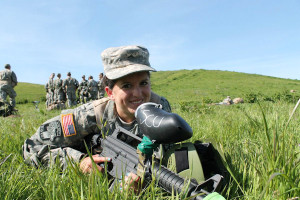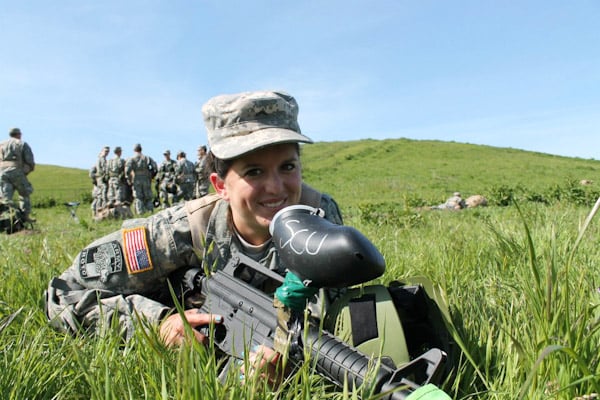Whenever Kaitlyn Benitez-Strine ‘15 wears her uniform on campus, people tend to stay away.

“People consider me to be a police officer [when I’m in uniform],” Beitez-Strine, a Stanford Army Reserve Officers’ Training Corps (ROTC) cadet and symbolic systems major, said. “I hate first impressions in my uniform…Right now, I’m wearing a white, frilly dress, and that’s what I love. I like to be cute and girly. But you see me first in uniform, you just have a huge wrong impression, and that’s sort of what this civilian-military gap is.”
Continuing a tradition from last year, all 14 Stanford ROTC cadets started wearing their uniforms to class once a week in hopes of raising more awareness about this gap at Stanford.
The ROTC program was removed from the University in 1970 and was invited back in March 2011.
ROTC is a college-based program through which students train to be commissioned military officers. At Stanford, Army ROTC candidates must complete courses and practical training activities at Santa Clara University and Fort Camp Parks in Dublin, Calif. Navy and Marine Corps ROTC students enroll in courses at UC-Berkeley, while Air Force ROTC students take courses at San Jose State University.
This year, four new cadets have joined the four-year Army ROTC program at Stanford. A total of seven cadets now participate in the program. Isabel Lopez ‘14 and Benitez-Strine are two returning students. Together, they share a two-room double in Branner Hall, an upperclass dorm with a public service focus.
“I knew I wanted to serve in some sense, and I wanted to work for the government at some point,” Lopez said. “After 9/11, I started thinking more about the military. After I started doing some research, I just thought that this would be something I want to do, and it was just confirmed once I started ROTC. Now that I’m in it, I’m happy that I could serve in this way.”
Benitez-Strine hails from a military family. Both of her parents attended the United States Military Academy at West Point. Her older sister is currently at the United States Naval Academy, in addition to aunts, uncles and cousins who all serve in various branches of the military.
“No one has come up and screamed in my face about it,” Benitez-Strine chuckled. “I was really nervous about that, coming here. It was a factor in my decision. I was nervous that people wouldn’t accept me well. I even put in my roommate agreement, ‘I hope the people won’t hate me because I’m in ROTC, so please put me with a roommate that won’t hate the Army.’”
Lopez and Benitez-Strine both start their mornings off early every week. For Lopez, her alarm goes off at 5 a.m. at least five times a week, and some weeks include all-day training events on the weekends. Similarly, Benitez-Strine wakes up at 6:30 a.m. on Mondays, Wednesdays and Fridays for physical training at Arrillaga Gym. Their commute times to Santa Clara University range from 15 minutes to two hours, depending on traffic. They stress time management as essential to enduring their hectic schedules.
“I’ve learned that I really need to start getting to bed no later than 10:30 p.m.,” Lopez said. “Just like any other Stanford student, I just have to have really good time management because I know that if I don’t, then I’m going to be paying for it the rest of the week.”
According to Captain Tim Hsia MBA ‘14 J.D. ‘14, a military history instructor at Santa Clara University and a current Stanford graduate student, the program has seen more support from the University. This is due, in large part, to the “unsung heroes” who supported the return of ROTC, including the military veterans and junior military officers who were cadets in 2011.
Recent changes include funding from the Haas Center for Public Service toward Zipcars that allow cadets to commute to their training sites, recognition as an official student organization, permission to take part in the annual Activities Fair in White Plaza and a physical office for the Army branch of ROTC in Sweet Hall. But most importantly for Lopez, cadets can now receive activities and academic credit for their ROTC classes.
“Just last year, we were able to get our ROTC classes approved as Stanford units,” said Lopez, a history major concentrating in global affairs and world history with a minor in modern languages. “That’s a huge deal. Ever since ROTC got kicked off campus, no one has been getting credit for their ROTC classes. So that was a huge step because for someone like me, I might be worried about graduating on time if I didn’t have those units…It’s just nice to be recognized now.”
This Sunday at 10 a.m., the Stanford Military Service Network will host a panel of alumni at Sigma Nu to discuss how their Stanford and military experiences influenced each other. Lopez and Benitez-Strine are both affiliated with the organization
“The overall campus attitude towards military recruitment and the ROTC program at Stanford has improved, and that’s due in large part to the professionalism of Stanford cadets who have graduated and also the professionalism of current cadets,” Hsia said in an email to The Daily.
One major problem though, according to Lopez, is the lack of cross-collaboration and exchange with the greater Stanford community. According to Lopez, one of the most important advantages that a Stanford education can give to a member of the military is the interaction the campus provides with people from diverse backgrounds.
According to Benitez-Strine, the best solution for those seeking change within the U.S. military is to serve, so that they can gain perspective and better understanding. She wishes there were more interaction between the small military community on campus and the rest of the student body. Lopez echoed this sentiment and encouraged mutual learning, connection-making and coming together of diverse groups—despite heated protests from several student organizations in spring 2011 involving military recruitment and ROTC on campus.
“There was friction between the military community and other groups on campus,” Lopez said. “That makes right now a crucial time period for improving civilian-military relations on campus.”
“ROTC is only a small part of the issue…It’s good to get the word out about ROTC, but ultimately what I’d like to see is mutual cooperation and defining different ways to serve together, to learn from one another between the civilian sector and the military.”
